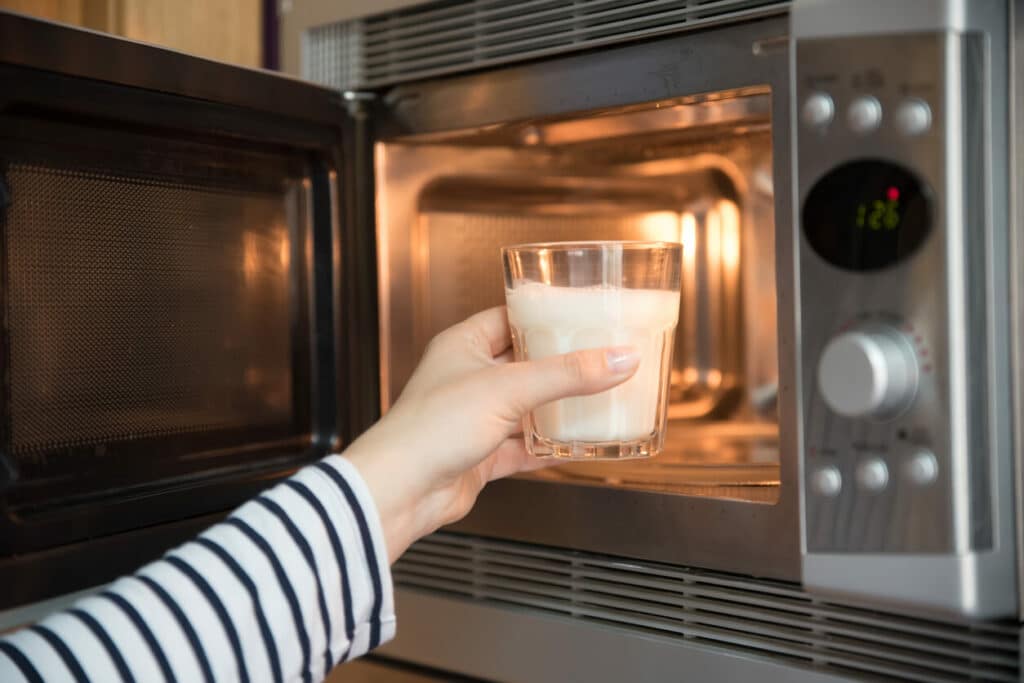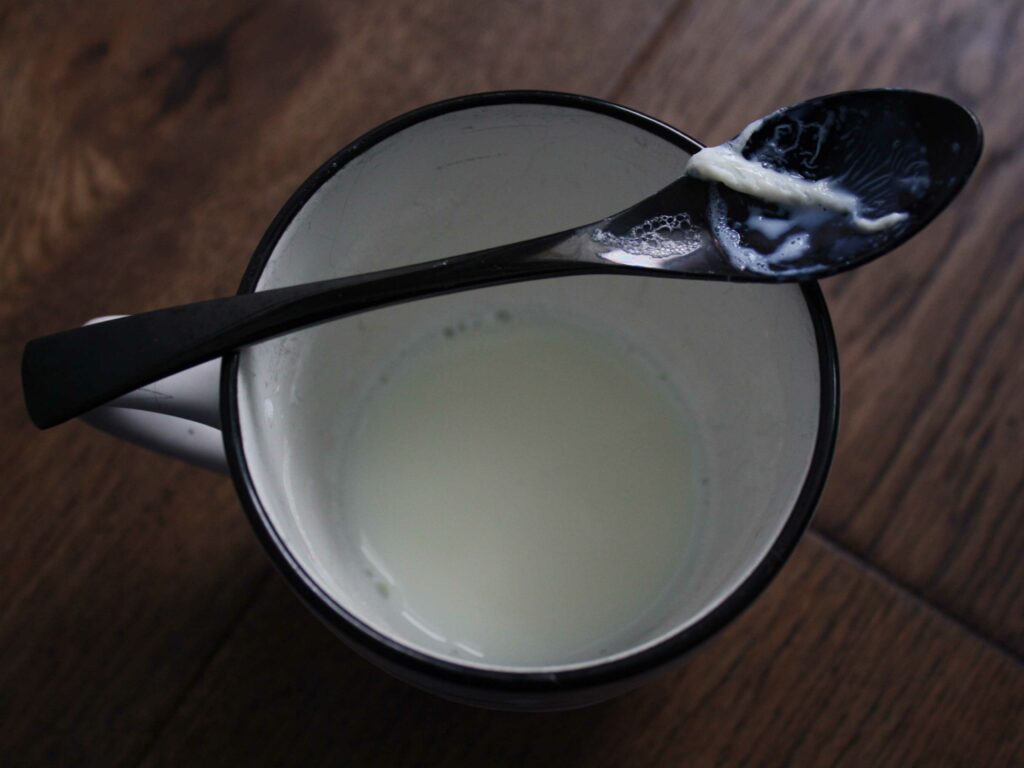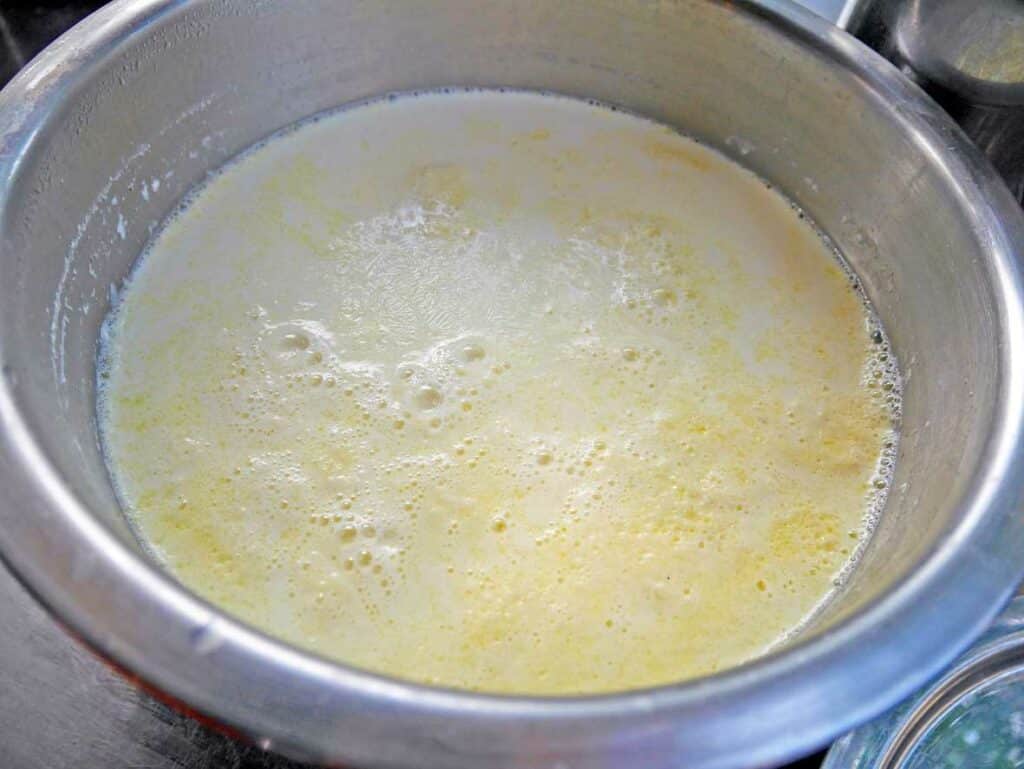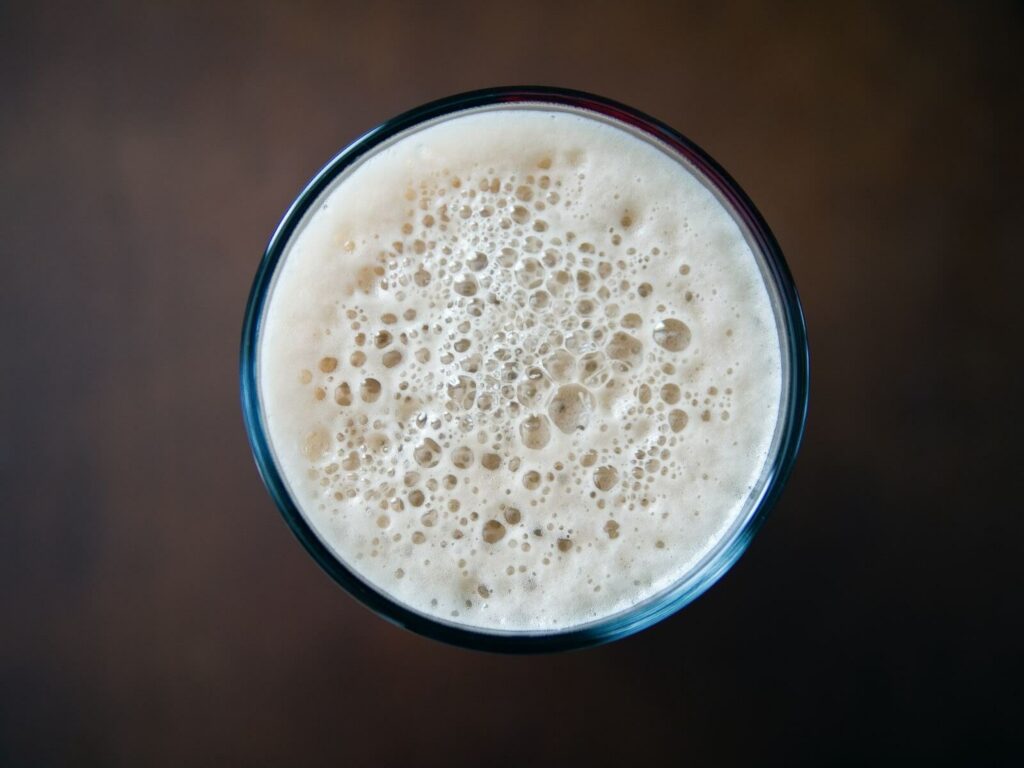Can You Microwave Milk? This Is The Ultimate Guide To Learn How

This guide will answer this year's million-dollar question, which is: "Can You Microwave Milk?", but it will also dig deeper to show you why and how!
A TikTok of an American woman went viral when she showed the world how to make the perfect cup of tea.
Why?
Because she microwaved it.
It caused a lot of controversy all over the world! People from the UK were appalled at her daring to microwave a cup of tea. While others claimed there was nothing wrong with it.
The debate split the whole world in two…
Now let’s dive into the reason why you are here: can you microwave milk?
If you are a coffee or tea drinker, chances are you microwave your milk prior to adding it to your favorite caffeinated beverage.
And there is nothing wrong with that! Indeed, you can microwave milk!
But there is a proper way to do it! So we will take a look at how you can safely microwave milk while avoiding those unappetizing clumps and making your milk as sweet as possible.
We’ll also give you some guidance when it comes to non-dairy milk options.
Let’s get started!
Can You Heat Milk in the Microwave?
The simple answer is: yes, you can microwave milk!
However, there is a proper way to do it!
So don’t run away yet... You might end up boiling the milk, creating a huge mess.
Worse, you could get that gross and unpleasant protein film on top of it, like in the picture below. Have you ever accidentally drunk a bit of that?
It’s enough to put you off milk for life.

The key here is to gently warm up your milk, stir frequently and use a thermometer!
Yes, using a thermometer might seem a bit extreme, but using your finger to gauge the temperature is not the most precise way of doing things plus you may burn yourself.
We promise you, your milk will taste sweeter and much better if you heat it to the proper temperature.
The sweet spot (pun intended) for milk is a temperature between 135-150°F (57-66°C).
If your milk’s temperature is too low, it will not taste as sweet, and if your milk’s temperature is too high, it will start to curdle and can taste burnt.
Is It Safe to Microwave Milk?
Yes, you can microwave milk safely if you do it properly.
The biggest risk is burning yourself. When you microwave milk, the heat is not evenly distributed and hot spots develop. You may think the milk is cool enough to drink until it’s in your mouth and burn yourself.
To avoid this issue (and other issues - more on this below), it’s very important to stir your milk during and after the heating process.
Another risk is microwaving your milk so much until it reaches its boiling point. At that point, it will quickly spill and create a huge mess. Good luck cleaning the milk crust from your microwave.
Another likely risk of warming milk in the microwave is not using microwave-safe mugs or containers. But this risk applies to any type of food or drink.
So what’s so special about milk that it needs so much care in the microwave?
To find out, let’s learn how a microwave heats milk.
What Happens to Milk in the Microwave?
Microwaves use electromagnetic waves at a frequency of 2.4 GHz. This frequency falls within the microwave range of the electromagnetic spectrum - hence the name given to these ovens.
Water molecules readily absorb radiation at 2.4 GHz, and when they do, they start vibrating quicker, and their temperature increases.
In other words, microwave ovens target water molecules, which get hot, and in turn, heat everything around them. This is why, for example, your mug does not get as hot as your drink.
Going back to dairy, whole milk consists on average of 87% water while the remaining 13 percent consists of fat, proteins, lactose, and minerals.
When you heat milk in the microwave, the water molecules will start vibrating more quickly than the other molecules in your drink. This causes the water to separate from the fat in the milk, while the high temperature of the water molecules can cause the milk’s proteins to change shape (unfold), resulting in clumps.
Because water heats up more quickly in the microwave than other compounds in your milk, the key is to heat the milk for a few seconds, then stir it, to ensure a more even heat distribution.
Note though, that if you heat your milk too much there is no avoiding milk clumps.
Given my engineering background, it’s tempting to go into more detail and boring you to death, LOL! But I won’t... So for the few who are interested in this, check this article on the physics of microwaves.
Does Microwaving Milk Diminish its Nutrients?
No, as demonstrated by a few studies.
The first, a study entitled Effect of microwave heating on vitamins A, E, B1, B2 and B6 in milk in the Journal of Dairy Research concluded that microwaving milk to 181°F (83°C) did not result in any significant losses in vitamins A, E, B1, B2 and B6. Only when milk was exposed to extreme conditions (temperatures exceeding 212°F (100°C) for extended periods of time) significant vitamin degradation was observed.
Another paper entitled Mineral Balance in Milk Heated Using Microwave Energy, published in the Journal of Agricultural and Food Chemistry, compared milk heated to 167 to 185°F (75 to 85°C) using a microwave and a water bath. The study concluded that no significant differences in salt partitioning and calcium ion levels were observed between the two samples.
Significantly, this study demonstrated that microwave heating was no more detrimental than conventional heating to milk, to the point that microwave heating could be used for pasteurization purposes.
(But please, do not attempt to pasteurize your own milk using any method! You could get really sick.)
What are the Advantages of Heating Milk in the Microwave?
Microwaving milk offers many advantages over conventional heating:
- Microwaving milk is quicker than conventional heating
- Microwaving milk requires less equipment and thus less cleaning
- It uses less energy than a conventional stove so it’s more environmentally friendly
What are the Disadvantages of Heating Milk in the Microwave?
When you microwave milk, you risk:
- Overheating it to the point it boils and overflows, creating a huge mess
- The development of hot milk spots that could burn your mouth
- These same “hot spots” will come into contact with the milk’s fat and proteins, causing clumps and that nasty protein film we are all too familiar with
- It’s easy to get distracted - a few seconds could mean the difference between delicious warm milk and scorched milk
However, as we’ve noted, the above issues can be fully mitigated by properly heating your milk in the microwave!
Let’s see how!
How to Heat Milk in the Microwave Properly
Now that we know a bit about microwaves and why they create hot spots and curdle your milk, let’s learn how to avoid these pesky issues.
Again, the key is to gently heat and stir frequently. Also, a thermometer is your friend!

To heat milk in the microwave:
- Select a microwave-safe mug or container and fill it with the amount of milk you need to heat up. I recommend you leave some space in case you get distracted - your milk will not immediately create a mess.
- Select the medium power setting in your microwave.
- Heat your milk for 15 seconds. Remove the container from the microwave and stir the milk with a spoon to help distribute the heat within your cup.
- Check the temperature with a thermometer. At this stage, your milk will not be hot enough, but it will give you an idea of how much the milk has been heated, allowing you to estimate how much longer the milk needs to be heated.
- Continue heating the milk in 15-second intervals. Stir with a spoon after every 15-second interval, and check the temperature with a thermometer.
- Once you reach the desired temperature between 57-66°C (135-150°F) your milk is ready. Do not be tempted to heat it further or it will lose its sweetness, or worse, you could scald it.
The total heating time should be around 45 to 60 seconds for 8.5 oz (250 mL) of milk. But this depends on your microwave oven, initial milk temperature, fat content, and other factors.
Once you try this a few times, you will not need a thermometer as you will learn how many 15-second intervals are needed to heat your milk to the perfect temperature!
Voila! With the correct heating method, microwaved milk can be as good as if you were to heat it on the stovetop.
Tip:
When you pour milk into a beverage such as coffee, tea, or hot cocoa, make sure the drink is not too hot. Overly hot beverages could suddenly increase the milk’s temperature and cause curdling.
How to Heat Non-Dairy Milk in the Microwave Properly
You can of course heat different types of non-dairy milk in the microwave, including oat milk, almond milk, and soy milk, amongst others.
Since these types of milk also contain some fat and proteins, the key is again gentle heating.
How to Heat Oat Milk in the Microwave Properly
Oat milk is quite starchy so it’s important you heat it in intervals while stirring frequently.
- Select a microwave-safe mug or container and fill it with the amount of oat milk you need. Make sure you leave some space in case you get distracted - your milk will not immediately create a mess.
- Select the medium power setting in your microwave.
- Heat your oat milk for 15 seconds. Remove it from the microwave, and stir with a spoon to help distribute the heat within your cup.
- Check the temperature with a thermometer. At this stage, your milk will not be hot enough, but it will give you an idea of how much the milk has been heated, allowing you to estimate how much longer the milk needs to be heated.
- Continue heating the oat milk in 15-second intervals. Stir with a spoon after every 15-second interval, and check the temperature with a thermometer.
- We recommend you stop once your thermometer reads between 135-150°F (57-66°C). Although oat milk does not have the same sweet point as cow milk (it does not have lactose), this will ensure you do not overheat your oat milk.
Also, remembering one single temperature range for all kinds of milk is practical.
How to Heat Soy Milk in the Microwave Properly
Soy milk is amongst the healthiest and most nutritious of all kinds of milk, despite some unfortunate popular myths. So it’s a great alternative to cow milk if you’re looking to shed some pounds.
Soy milk, however, has its unique set of proteins that are very sensitive to heat and acidity. Extra care is required when microwaving soy milk unless you want to make tofu!

- Select a microwave-safe mug or container and fill it with the amount of soy milk you need. Make sure you leave some space in case you get distracted - your milk will not immediately create a mess.
- Select the low-power setting in your microwave.
- Heat your soy milk for 5-10 seconds. Remove from the microwave, and stir with a spoon to ensure it is heated evenly.
- Check the temperature with a thermometer. At this stage, the soy milk will not be hot enough, but it will give you an idea of how much the milk has been heated, allowing you to estimate how much longer the milk needs to be heated.
- Continue heating the milk in 5 to 10-second intervals. Stir with a spoon after every interval, and check the temperature with a thermometer.
- We recommend you stop once your thermometer reads between 135-150°F (57-66°C). Again, the proteins in soy milk easily denaturalize when exposed to excessive heat so keeping the temperature low is key.
Pro Tip:
Coffee is an acidic drink, which can cause soy milk to denaturalize and create clumps. Thankfully not all coffee beans are created equal!
We highly recommend you use medium-dark or dark roast coffee beans as they are less acidic than lighter roast beans!
If your coffee is too acidic, your soy milk will clump up even if you warmed it perfectly in the microwave.
If you are a tea drinker, you should be okay with any type of tea as teas are mildly acidic.
How to Heat Almond Milk in the Microwave Properly
Almond milk has become very popular around the world, but not so popular with us.
In the US, almonds are almost exclusively grown in California’s dry Central Valley and occupy an area the size of Delaware. They require almost 70 percent of all US bees for pollination, and one glass of almond milk requires about 130 glasses of water.
Yikes!
However, we will forgive you if you use almond milk in your drinks because this type of milk at least has lower impacts than dairy milk.
To heat almond milk in the microwave:
- Select a microwave-safe container or mug and fill it with the amount of almond milk you need. I recommend you leave some space in case you get distracted - your milk will not immediately create a mess.
- Select the medium power setting in your microwave.
- Heat your almond milk for 15 seconds. Remove it from the microwave and stir it with a spoon to evenly distribute the heat within your cup.
- Check the temperature with a thermometer. At this stage, your almond milk will not be hot enough, but this should give you an idea of how much the milk has been heated, thereby allowing you to estimate how much longer the milk needs to be heated.
- Continue heating the almond milk in 15-second intervals. Stir with a spoon after every 15-second interval, and check the temperature with a thermometer.
- Once your thermometer reads between 135-150°F (57-66°C) your milk is ready.
How to Froth Milk in the Microwave
If you don’t have a fancy espresso machine, like a Breville espresso machine, a De'Longhi machine, or even one of those high-end Nespresso machines, you can still froth milk using a microwave! It’s really quick and easy to use your microwave to do so.
- Simply get a microwave-safe container with a lid, like a mason jar.
- Pour your milk in and fill it halfway.
- Heat your milk as per the instructions above (heat in 15-seconds intervals and stir in between while checking for the temperature).
- When the milk is heated, it’s time to work out those biceps! Put the lid on and shake it for up to 60 seconds.
And there you have it, delicious frothy milk to add to make a cappuccino or latte, or hot chocolate. You could even make a delicious boba latte!
However, we do recommend buying a budget-friendly handheld frother if you're looking to make delicious microfoam! Here's one we use daily:
Can You Microwave Milk More Than Once?
No. Reheating milk that has been sitting out or heated before can be dangerous and cause illness. There is more chance of bacteria getting into it and releasing toxins, which reheating won’t be able to get rid of.
Even if it was safe to reheat milk, drinking it won’t be pleasant to drink. So, heated milk should be used only once.
Alternative Ways to Heat Milk
If after all this information you’ve decided that you’d rather not heat milk in the microwave, then there are other ways.
You can of course use the stove, oven, or preferably a bain-marie (double boiler method). If you are pressed for time, let a dragon breathe on it.
Ok, that last one is a joke, and even if it weren’t, we definitely wouldn’t recommend it. Your drink might be warm but you’ll probably have no eyebrows.
Remember, when heating milk, regardless of which method you use, the key is gentle heating with lots of stirring.
People Also Search For:
- Here’s How to Make 7 Delicious Oat Milk Latte Recipes
- Latte vs Cappuccino vs Macchiato: The Main Differences Explained
Frequently Asked Questions
Can I heat milk in the microwave?
Yes, you can heat milk in the microwave. It is safe and milk will not lose its nutritional value based on research.
The key is to warm the milk gently. To do so, heat it in 15-second increments and stir in between. When you stir milk, it eliminates any hot spots which could burn you and cause protein coagulation (yuk).
Many people claim the taste will not taste as good, but the reason is they are likely having burnt milk. Milk has an optimal temperature for sweetness between 135-150°F (57-66°C).
What happens if you put milk in the microwave?
The milk’s water particles will start vibrating faster and thereby increase in temperature, which in turn heats the other surrounding compounds in the milk.
How long can milk be microwaved?
It’s best not to warm milk longer than 45 to 60 seconds, depending on your microwave power. You should also warm milk slowly by selecting a shorter time, checking it, and then doing another short burst. Make sure you use a thermometer - this timing depends on your microwave.
Can you microwave milk without it curdling?
Yes, you can. The key is interval heating (15-second intervals) and frequent stirring.

Bottom Line
So, can you microwave milk?! I bet we answered this question better than you thought we would, right?!
Whether you’re happy to microwave your milk, or think it’s an abomination, it is safe to do so. In addition, research shows the nutritional value of milk is not significantly impacted by microwaves.
The key is gently heating your milk in intervals and stirring in between. It’s also important to check the temperature with a thermometer because dairy milk has a sweet spot.
Non-dairy milk can also be heated in the microwave using short intervals. However, soy milk is particularly sensitive to heat and acidity so make sure you follow our recommendations!
Microwaving milk is a fast way of heating milk up for a nice cup of warm milk before bed! It should be enough to send you to the land of nod.
It’s also a great way to create milk foam without digging into your pocket.
This article is intended for informational purposes only. It is not meant to replace professional medical advice, treatment or diagnosis. Do not consume any type of coffee, tea or herbal infusion if you are allergic to it. The information in this article is not intended to treat serious medical conditions. Please seek professional medical advice before using home remedies.
.

